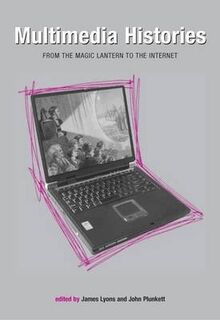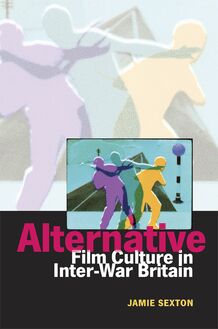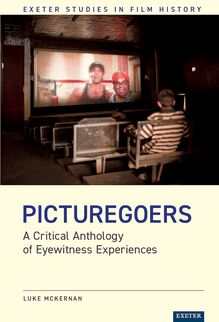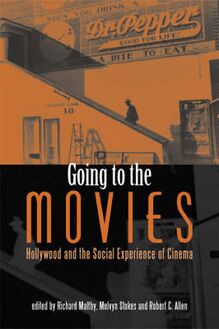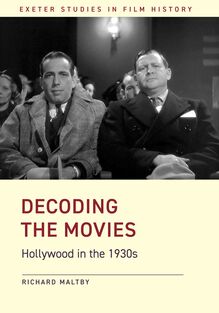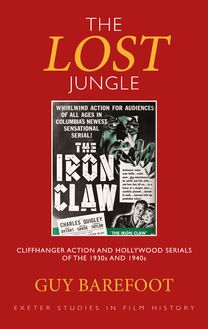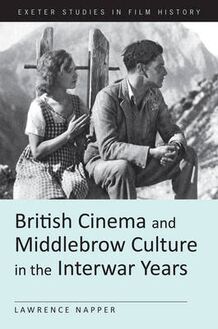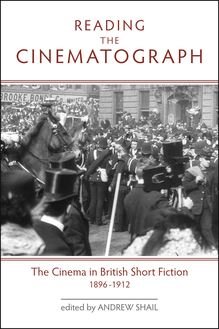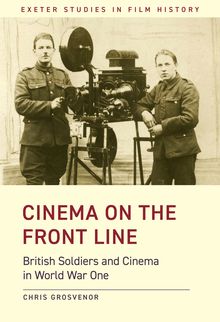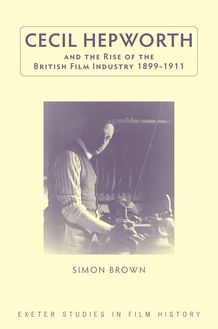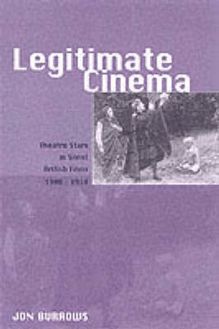-
 Univers
Univers
-
 Ebooks
Ebooks
-
 Livres audio
Livres audio
-
 Presse
Presse
-
 Podcasts
Podcasts
-
 BD
BD
-
 Documents
Documents
-
- Cours
- Révisions
- Ressources pédagogiques
- Sciences de l’éducation
- Manuels scolaires
- Langues
- Travaux de classe
- Annales de BEP
- Etudes supérieures
- Maternelle et primaire
- Fiches de lecture
- Orientation scolaire
- Méthodologie
- Corrigés de devoir
- Annales d’examens et concours
- Annales du bac
- Annales du brevet
- Rapports de stage
La lecture à portée de main
Vous pourrez modifier la taille du texte de cet ouvrage
Découvre YouScribe en t'inscrivant gratuitement
Je m'inscrisDécouvre YouScribe en t'inscrivant gratuitement
Je m'inscrisEn savoir plus
Vous pourrez modifier la taille du texte de cet ouvrage
En savoir plus

Description
The main question addressed in this book: why has the Hollywood sound serial received so little scholarly attention? The sound serial was extremely popular in the 1930s and 1940s, with serials made by companies such as Universal and Columbia. At children’s matinees they were enthusiastically received, but were also part of a regular programme of neighbourhood cinemas in the United States. Eventually, this phenomenon went global and was a popular alternative to a feature film, regardless of whether they were screened individually or in a single sitting.
Many works on the sound serial are written both by and for fans, with little more than a collection of image stills and brief summaries. Here, the author presents a thorough analysis based on detailed historical research, focusing on the period between 1930, when serials were born, and 1946, when Universal stopped their production.
As well as exploring particular films, the author situates them in American film culture and societal practice of film viewing. The production of the serials is also considered, examining how it drew upon previous conventions such as silent cinema and melodrama.
This book will be a vital component in the study of American film, as it explores a previously untouched niche in great detail, offering an accessible yet academic perspective on the growth and decline of Hollywood sound serials.
¨ The Serial and the Cliffhanger: Definitions and Origins
¨ Thursday Night at the Ritz: Exhibition, Audiences and Regulation
¨ The Economy Chapter
¨ The Second Chapter, 1930-46
¨ Four Serials and a Feature, 1932-38
¨ Where are you now, Batman? Aftermath and Conclusion
Sujets
Informations
| Publié par | University of Exeter Press |
| Date de parution | 31 juillet 2019 |
| Nombre de lectures | 0 |
| EAN13 | 9780859892711 |
| Langue | English |
Informations légales : prix de location à la page 0,5625€. Cette information est donnée uniquement à titre indicatif conformément à la législation en vigueur.
Extrait
The Lost Jungle
In the 1930s and the 1940s, in the US and elsewhere, cinema-goers saw not just a film but a programme that might include a double-bill, one or more shorts, and a serial. The latter, consisting of up to fifteen episodes shown at weekly intervals, were not confined to children’s matinees but were part of the regular bill at numerous neighbourhood theatres. In some countries they were the main attraction.
Serials such as Flash Gordon and The Lone Ranger were extra- ordinarily popular; others provided a reliable return for the studios that produced them: Universal, Columbia, Republic, Mascot and a handful of other Poverty Row outfits.
The Lost Jungle will help revive and re-invigorate the study of 1930s and 1940s Hollywood serials. It examines the episodic structure and melodramatic nature of serials made in Hollywood during the Great Depression and the Second World War and their places within the American film industry and American culture.
Guy Barefoot is Lecturer in Film Studies, Director of Studies, History of Art and Film, and member of the Centre for American Studies at the University of Leicester
Exeter Studies in Film History
Published by University of Exeter Press in association with the Bill Douglas Centre for the History of Cinema and Popular Culture
Series Editors: Richard Maltby, Professor of Screen Studies, Flinders University Steve Neale, Professor of Film Studies, University of Exeter
Parallel Tracks: The Railroad and Silent Cinema , Lynne Kirby (1997)
The World According to Hollywood, 1918–1939 , Ruth Vasey (1997)
‘Film Europe’ and ‘Film America’: Cinema, Commerce and Cultural Exchange 1920–1939 , edited by Andrew Higson and Richard Maltby (1999)
A Paul Rotha Reader , edited by Duncan Petrie and Robert Kruger (1999)
A Chorus of Raspberries: British Film Comedy 1929–1939 , David Sutton (2000)
The Great Art of Light and Shadow: Archaeology of the Cinema , Laurent Mannoni, translated by Richard Crangle (2000)
Popular Filmgoing in 1930s Britain: A Choice of Pleasures , John Sedgwick (2000)
Alternative Empires: European Modernist Cinemas and Cultures of Imperialism , Martin Stollery (2000)
Hollywood, Westerns and the 1930s: The Lost Trail , Peter Stanfield (2001)
Young and Innocent? The Cinema in Britain 1896–1930 , edited by Andrew Higson (2002)
Legitimate Cinema: Theatre Stars in Silent British Films 1908–1918 , Jon Burrows (2003)
The Big Show: British Cinema Culture in the Great War (1914–1918) , Michael Hammond (2006)
Multimedia Histories: From the Magic Lantern to the Internet , edited by James Lyons and John Plunkett (2007)
Going to the Movies: Hollywood and the Social Experience of Cinema , edited by Richard Maltby, Melvyn Stokes and Robert C. Allen (2007)
Alternative Film Culture in Inter-War Britain , Jamie Sexton (2008)
Marketing Modernity: Victorian Popular Shows and Early Cinema , Joe Kember (2009)
British Cinema and Middlebrow Culture in the Interwar Years , Lawrence Napper (2009)
Reading the Cinematograph: The Cinema in British Short Fiction 1896–1912 , edited by Andrew Shail (2010)
Charles Urban: Pioneering the Non-fiction Film in Britain and America, 1897–1925 , Luke McKernan (2013)
Cecil Hepworth and the Rise of the British Film Industry 1899–1911 , Simon Brown (2015)
The Appreciation of Film: The Postwar Film Society Movement and Film Culture in Britain , Richard Lowell MacDonald (2016)
Celluloid War Memorials: The British Instructional Films Company and the Memory of the Great War , Mark Connelly (2016)
UEP also publishes the celebrated five-volume series looking at the early years of English cinema, The Beginnings of the Cinema in England , by John Barnes.
First published in 2017 by University of Exeter Press Reed Hall, Streatham Drive Exeter EX4 4QR UK www.exeterpress.co.uk
© Guy Barefoot 2017
The right of Guy Barefoot to be identified as author of this work has been asserted by him in accordance with the Copyright, Designs and Patents Act 1988.
Although every effort has been made to identify owners of copyright material, in some cases this has not been possible. Notification of omissions or incorrect information should be forwarded to the publishers, who will be pleased to amend any future editions of the book.
British Library Cataloguing in Publication Data A catalogue record for this book is available from the British Library.
ISBN 978 0 85989 887 4 Hardback ISBN 978 0 85989 271 1 ePub ISBN 978 0 85989 265 0 PDF
Typeset in Caslon by Short Run Press Ltd, Exeter
Contents
List of Illustrations
Acknowledgements
Introduction
1 The Serial and the Cliffhanger: Definitions and Origins
2 Thursday Night at the Ritz: Exhibition, Audiences and Regulation
3 The Economy Chapter
4 The Second Chapter, 1930–46
5 Four Serials and a Feature, 1932–38
Where are you now, Batman? Aftermath and Conclusion
Appendix : Holly-wood Serials 1930–1946 and the endings of their second chapters
Notes
Bibliography
Index
Illustrations
1 The Lost Jungle (1934)
2 Motion Picture Herald , 2 October 1937, p. 93
3 Radio Patrol (1937)
4 Mandrake the Magician (1939)
5 Ace Drummond (1936)
6 The Green Hornet (1939)
7 Perils of Nyoka (1942)
8 Undersea Kingdom (1935) Chapter Two
9 Undersea Kingdom (1935) Chapter Three
10 G-Men versus the Black Dragon (1943)
11 G-Men versus the Black Dragon (1943)
12 G-Men versus the Black Dragon (1943)
13 G-Men versus the Black Dragon (1943)
14 Flash Gordon (1935)
15 Clancy of the Mounted (1933)
16 The Lost Special (1932)
17 The Whispering Shadow (1933)
18 The Whispering Shadow (1933)
19 Jungle Jim (1936)
20 Jungle Jim (1936)
21 Daredevils of the Red Circle (1939)
22 Daredevils of the Red Circle (1939)
Acknowledgements
My thanks to James Chapman for supporting my original idea back in 2006, to the University of Leicester for giving me study leave to pursue it, and to the British Academy for funding an initial research trip to the United States. That took me to Los Angeles and New York as well as to Brigham Young University in Utah. I am grateful for the help given to me at the USC Cinematic Arts Library, UCLA Special Collections, the Margaret Herrick Library, the Museum of the American West, the Howard B. Lee Library at Brigham Young and the New York Library for the Performing Arts. Thanks also to staff at the Library of Congress in Washington and at the British Film Institute, the British Library and the Public Records Office in London, as well as at the University of Leicester Library. Others have enabled me to do much of my research without travelling, notably the Media History Digital Library Team. The page reproduced from Motion Picture Herald is from their website. My thanks to Brian Patten for permission to quote from his poems, ‘Where are you now, Batman?’ and ‘Where are you now, Superman?’ I am also indebted to all those fans, collectors and suppliers who have kept the serial alive and have allowed me to watch serials that earlier accounts identified as lost, as well as others that somehow got missed off the film studies curriculum. An earlier version of Chapter Two appeared in the Historical Journal of Film, Radio and Television . I am very grateful to Anna Henderson for picking up on this and commissioning this book for University of Exeter Press, to Simon Baker for his subsequent editorial work, and to the series editors of the Exeter Studies in Film History. Thanks also to Anna Claydon, Phyll Smith, Luke Terlak Poot (even if we didn’t manage to track down that elusive Sol Shor article on the cliffhanger) and to colleagues and students in the Department of History of Art and Film and the Centre for American Studies at the University of Leicester.
Introduction
Near the beginning of Mascot Pictures’ The Lost Jungle (1934), Captain Robinson tells his daughter Ruth that unless lion-tamer Clyde Beatty agrees to marry her he will insist that she accompany him on his South Sea expedition. Clyde loves Ruth, but is preoccupied with his lions, and Ruth accompanies her father. Like earlier Robinsons, father and daughter find themselves shipwrecked. When Clyde learns of this, he joins a search party, but the dirigible chartered by the search party is struck by lightning. It crash lands on the very island where Clyde’s fiancé and her father are sheltering. The lion-tamer encounters assorted wild animals, some of which he eventually takes back with him on the Captain’s repaired ship, and discovers the treasure hidden in the buried city of Kamor. At the end of the film he turns his attention away from his lions. Clyde and Ruth embrace.
At least, they do in the feature-length version. Poverty Row studio Mascot specialized in serials but by 1934 it was also making features and releasing films in serial and feature versions. The Lost Jungle was released as a twelve chapter serial, as a feature followed by ten chapters, and as a ‘straight feature’. 1 In the serial, Clyde and Ruth meet for the first time on the island. Romance is downplayed and more time is devoted to animal encounters and other life-threatening dangers. There is no closing embrace.
The serial itself survives in different versions. In one of these the second chapter begins with an explanatory voice-over:
The lost jungle is an island where lions, tigers, bears and other wild animals are found living together. How did they get there? Scientists declare that Asia and Africa were once joined by land which has sunk into the ocean. Only the tops of a few high mountains remain above water as islands.
The sequence is illustrated by an aerial shot of the island, a shot of animals fighting with a superimposed question mark that increases in size (Fig. 1), a map showing Asia and Africa joined together and an image of mountains above the sea. The crude stage prop waves provide a thin justification for the story’s inclusion of so many of the Hagenbeck-Wallace Circus animals in the wild on a So
-
 Univers
Univers
-
 Ebooks
Ebooks
-
 Livres audio
Livres audio
-
 Presse
Presse
-
 Podcasts
Podcasts
-
 BD
BD
-
 Documents
Documents
-
Jeunesse
-
Littérature
-
Ressources professionnelles
-
Santé et bien-être
-
Savoirs
-
Education
-
Loisirs et hobbies
-
Art, musique et cinéma
-
Actualité et débat de société
-
Jeunesse
-
Littérature
-
Ressources professionnelles
-
Santé et bien-être
-
Savoirs
-
Education
-
Loisirs et hobbies
-
Art, musique et cinéma
-
Actualité et débat de société
-
Actualités
-
Lifestyle
-
Presse jeunesse
-
Presse professionnelle
-
Pratique
-
Presse sportive
-
Presse internationale
-
Culture & Médias
-
Action et Aventures
-
Science-fiction et Fantasy
-
Société
-
Jeunesse
-
Littérature
-
Ressources professionnelles
-
Santé et bien-être
-
Savoirs
-
Education
-
Loisirs et hobbies
-
Art, musique et cinéma
-
Actualité et débat de société
- Cours
- Révisions
- Ressources pédagogiques
- Sciences de l’éducation
- Manuels scolaires
- Langues
- Travaux de classe
- Annales de BEP
- Etudes supérieures
- Maternelle et primaire
- Fiches de lecture
- Orientation scolaire
- Méthodologie
- Corrigés de devoir
- Annales d’examens et concours
- Annales du bac
- Annales du brevet
- Rapports de stage
